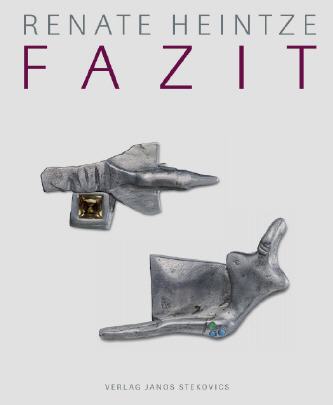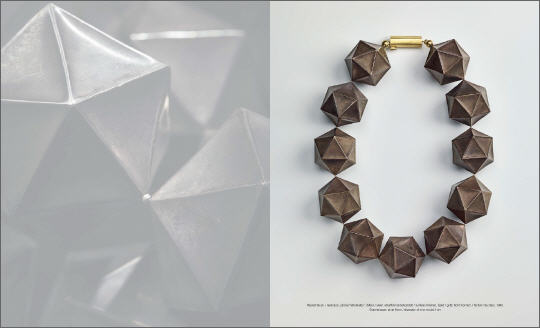Renate Heintze FAZIT
Renate Heintze. FAZIT
Herausgegeben von Renate Luckner-Bien in Verbindung mit Margit Jäschke
Mit Textbeiträgen von Petra Hölscher, Margit Jäschke, Christiane Keisch, Wolfgang Lösche und Katja Schneider sowie Fotografien von Janos Stekovics
Deutsch / Englisch
Format: 23 x 28 cm
96 Seiten, gebunden
25,00 Euro
ISBN 978-3-89923-375-9
Die Goldschmiedin Renate Heintze (1936–1991) leitete die Schmuckklasse an der Burg Giebichenstein Kunsthochschule Halle von 1974 bis zu ihrem Tod. Sie zählt zur Generation jener Schmuckkünstler, die in den sechziger Jahren des 20. Jahrhunderts die Grenzen traditionellen kunsthandwerklichen Arbeitens aufbrachen und zu Wegbereitern des internationalen Autorenschmucks wurden. Mit dem Titel „Renate Heintze. Fazit“ ist jetzt im Verlag Janos Stekovics eine Monografie über ihr Lebenswerk erschienen.
Nach einer Goldschmiedelehre in Naumburg studierte Renate Heintze von 1953 bis 1959 an der Burg Giebichenstein Kunsthochschule Halle. In den 1950er Jahren war die Schule in Halle an der Saale geprägt von zur Generation ihrer Gründer gehörenden Lehrern, die ihre Visionen und Ideale einer gemäßigten Moderne über die Nazizeit gerettet hatten und sich jetzt gegen das ideologisch motivierte staatliche Formalismus-Verdikt zur Wehr setzten. Renate Heintzes Lehrer, der Metallbildhauer Karl Müller, vermittelte eine am Ideal der Burg- und Bauhaus-Moderne geschulte Haltung, bei der sich disziplinierte Formensprache mit handwerklichem Können verbinden.
Nach zweijähriger Tätigkeit als Schmuckgestalterin in der Industrie und vier Jahren selbstständiger Arbeit als Goldschmiedin kehrte Renate Heintze 1966 an die Hochschule zurück und übernahm 1974 die Leitung der Schmuckklasse. Gemeinsam mit Dorothea Prühl entwickelte sie ein neues, auf das künstlerische Unikat gerichtetes Lehrkonzept. Gegen massive, der ostdeutschen Kulturpolitik der sechziger und siebziger Jahre geschuldete Widerstände gelang es, den halleschen Schmuck aus den Fesseln eines eng gefassten Traditions- und Funktionsverständnisses zu befreien. Die Eckpfeiler dieses Programms waren bildnerische Idee und formbildender Umgang mit unterschiedlichen Werkstoffen, Naturstudium im Sinne von Beobachtung und kontemplativer Auseinandersetzung mit dem Gegenstand und nicht zuletzt die gültige plastische Formulierung. In diesem Sinn ist Renate Heintze die Begründerin der halleschen Schmuckschule, die heute international Beachtung findet.
Ergänzt mit Entwurfsskizzen und Modellen, zeigt der umfangreiche Bildteil des Buches in großformatigen Abbildungen ausgewählte Arbeiten aus allen Werkgruppen der Künstlerin. Viele dieser Schmuckstücke befinden sich heute in öffentlichen und privaten Sammlungen. Größere Kollektionen besitzen das Kunstmuseum Moritzburg Halle, das Kunstgewerbemuseum Berlin und das GRASSI Museum für Angewandte Kunst in Leipzig. Seit der Ersteinrichtung der Danner-Rotunde 2004 sind Renate Heintzes Arbeiten als Ankauf der Danner-Stiftung auch in der ständigen Ausstellung der Neuen Sammlung in München zu sehen.
Der umfangreiche Bildteil wird ergänzt durch fünf kurze Essays renommierter Autorinnen und Autoren: Für Katja Schneider ist Renate Heintze eine Wegbereiterin des Autorenschmucks und ihr Werk exemplarisch für das heute gängige Selbstverständnis zeitgenössischer Schmuckkunst; Christiane Keisch sieht in Renate Heintze eine „Schlüsselfigur im Schmuckschaffen der DDR“ und beschreibt deren eigenständigen Beitrag für die Herausbildung des „Halleschen Stils“; die Künstlerin Margit Jäschke erinnert sich mit Dankbarkeit an ihre Lehrerin; Wolfgang Lösche betont, dass – nach Dorothea Prühl – mit Renate Heintze jetzt bereits die zweite Goldschmiedin aus Halle als „Klassiker der Moderne“ im Rahmen der Internationalen Handwerksmesse in München vorgestellt wird; für Petra Hölscher ist Renate Heintze aus dem Kanon des internationalen Autorenschmucks nicht mehr wegzudenken. Im Anhang des Buches gibt eine kommentierte und bebilderte Biografie dem Leser konzentriert Auskunft über Leben und Werk der Künstlerin.
Renate Heintze verdient Beachtung und Wertschätzung in der Reihe jener heute berühmten und einflussreichen Goldschmiede, die mit ihren Arbeiten wie auch als Lehrende Wegbereiter zeitgenössischer Schmuckkunst sind. Ihrem frühen Tod geschuldet, ist das heute nur wenig bekannt. Die Publikation „Renate Heintze. Fazit“ wird diese Lücke schließen.
Das Buch erscheint anlässlich der Ausstellung „Renate Heintze. Klassiker der Moderne“ im Rahmen der Sonderschau „Schmuck 2017“ und der Sonderausstellung „Renate Heintze, Dorothea Prühl und Schüler der Schmuckklasse der Burg Giebichenstein“ der Galerie MARZEE im Rahmen von FRAME auf der Internationalen Handwerksmesse München vom 8. bis 14. März 2017 sowie des Vortrags von Katja Schneider „Renate Heintze. Ihr Weg zum Autorenschmuck“ in der Neuen Sammlung – The Design Museum, Pinakothek der Moderne, München am 12. März 2017.
Die Publikation wurde gefördert durch die Kunststiftung des Landes Sachsen-Anhalt.
Renate Heintze. FAZIT
Edited by Renate Luckner-Bien in cooperation with Margit Jäschke
With text contributions by Petra Hölscher, Margit Jäschke, Christiane Keisch, Wolfgang Lösche and Katja Schneider along with photography by Janos Stekovics
German / Englisch
Format: 23 x 28 cm
96 pages
hardcover
ISBN 978-3-89923-375-9
Price: € 25.00
Publishing house Janos Stekovics, Dößel 2017
The goldsmith Renate Heintze (1936–1991) supervised the jewelry class at Burg Giebichenstein Kunsthochschule Halle from 1974 right until her death. She belongs to the generation of those jewelry artists who burst the confines of traditional artisanal work in the sixties of the 20th century and became the trailblazers of international studio jewelry. The book titled “Renate Heintze. Fazit“ has now been published in the publishing house Janos Stekovics as a monograph about her life’s work.
Subsequent to a goldsmith’s apprenticeship in Naumburg, Renate Heintze studied at the Burg Giebichenstein Kunsthochschule Halle from 1953 to 1959. In the 1950s the university in Halle (Saale) was shaped by the teachers who belonged to the generation of its founders, who had salvaged their visions and ideals of a tempered Modernism all through the Nazi times and were arming themselves against the ideologically motivated formalism verdict superimposed by the state. Renate Heintze’s teacher, the metal sculptor Karl Müller, conveyed a position underpinned by the ideal of the Burg and Bauhaus Modernism, in which the disciplined formal language was intertwined with artisanal skill.
After two years’ activity as a jewelry designer in the industry and four years of self-employed work as a goldsmith, Renate Heintze returned to the university in Halle in 1966 and took over the supervision of the jewelry class in 1974. Together with Dorothea Prühl she developed a new teaching concept which was orientated towards creating artistically unique specimen. In the face of massive opposition due to East German cultural politics of the sixties and seventies, it became possible to liberate Halle jewelry from the shackles of the restricted understanding of tradition and function. The pillars of this program were a visual idea and a handling with different materials, nature study in terms of observation and contemplative analysis the object and, not least, the valid plastic rendering. In this sense Renate Heintze is the founder of the Halle jewelry school, which enjoys international recognition nowadays.
Complemented by draft sketches and models, the comprehensive pictorial section of the book displays, in large-scale illustrations, the selected works from all work groups of the artist. Many of these jewelry pieces are to be found in public and private collections. Larger collections are hosted by the Kunstmuseum Moritzburg Halle, the Kunstgewerbemuseum Berlin and the GRASSI Museum für Angewandte Kunst in Leipzig. Since the opening of the Danner-Rotunda in 2004, Renate Heintze’s works can be seen in the permanent exhibition of the Neue Sammlung in Munich as an aquisition of the Danner Foundation.
The comprehensive pictorial section is complemented by five brief essays by renowned authors: for Katja Schneider, Renate Heintze is a trailblazer of studio jewelry and her work is exemplary for the self-conception of contemporary jewelry art common today; Christiane Keisch sees in Renate Heintze a “key figure in creating jewelry in the GDR“ and describes her independent contribution to the formation of the “Halle style“; the artist Margit Jäschke reminisces about her mentor with gratitude; Wolfgang Lösche emphasizes that – after Dorothea Prühl – with Renate Heintze the second goldsmith from Halle is now already represented within the scope of the Internationale Handwerksmesse in Munich as a “classic of Modernity“; for Petra Hölscher, Renate Heintze is an integral part of the canon of international studio jewelry. In the appendix to the book the reader can find an annotated and illustrated biography, giving condensed information about the artist’s life and work.
Renate Heintze deserves recognition and appreciation in the line of those goldsmiths, famous and influential today, who, both with their works and as teachers, have paved the way to our contemporary jewelry art. Because of her early death, this is only little known nowadays. The publication of the book “Renate Heintze. Fazit“ shall remedy this omission.
This book is published on the occasion of the exhibition “Renate Heintze. The Classic of Modernity“ within the framework of the special exhibition “Schmuck 2017 and of the special exhibition “Renate Heintze, Dorothea Prühl and the Jewelry Students of the Burg Giebichenstein“ in the gallery MARZEE within the scope of FRAME at the Internationale Handwerksmesse München 2017 as well as Katja Schneider’s lecture “Renate Heintze. Her Way to Studio Jewelry“ in the Neue Sammlung – The Design Museum, Pinakothek der Moderne, Munich, on March 12, 2017.
The publication was funded by the Kunststiftung des Landes Sachsen-Anhalt (Art Foundation of the Federal State of Saxony-Anhalt).
|
|



















